Serge Herosh and David Weinland separately invented and developed revolutionary methods for measuring and controlling individual particles while maintaining their quantum-mechanical nature, in ways previously considered impossible
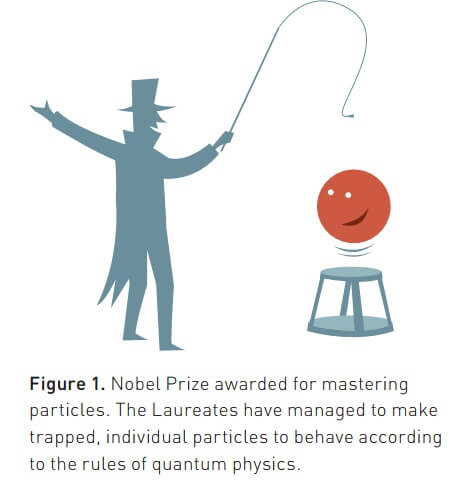
Controlling particles in the quantum world
Serge Herosh and David Wineland separately invented and developed revolutionary methods for measuring and controlling individual particles while maintaining their quantum-mechanical nature, in ways that were previously considered impossible.
Weinland and Roche opened the door to a new era of experiments in the field of quantum physics by demonstrating direct observation of individual quantum systems without destroying them. With the help of their ingenious laboratory methods, they were able to measure and control very delicate quantum states, a result that makes their field of research take its first steps towards developing a new type of extremely fast computer based on quantum physics. Their methods also contributed to the construction of extremely accurate clocks that could form the future basis for the new standard of time measurement, with an accuracy one hundred times higher than today's cesium clocks.
The laws of classical physics do not apply to individual particles of light or matter, and at this point the laws of quantum physics take over. However, it is not easy to isolate individual particles from their immediate environment and they soon lose their mysterious quantum properties the moment they come into contact with the world around them. Therefore, many phenomena that seem strange to us and which are predicted according to quantum mechanics, are not even directly observable, and scientists today can only perform "thought experiments" that may hint at the existence of these strange phenomena.
The two laureates work in the field of quantum optics, a field that examines the fundamental interactions between light and matter, a field that has progressed significantly since the mid-XNUMXs. Their methods have similar characteristics. David Weinland managed to capture electrically charged atoms, or as they are known as ions, while controlling their measurement using light, or photons. Serge Harush took the opposite approach - he controls and measures trapped photons, or particles of light, by passing atoms through a trap.
Control of individual ions within a trap
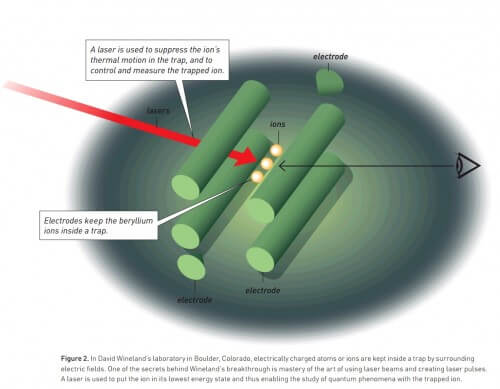
In David Wineland's laboratory in Boulder, Colorado, pigeons are kept inside a trap by surrounding them with electric fields. The particles are isolated from the heat and radiation of their surroundings by performing the experiments in a vacuum at extremely low temperatures.
One of the secrets behind Vineland's breakthrough is the mastery of the art of using laser beams and creating laser pulses. The laser is used to suppress the thermal motion of the ions inside the trap, forcing the ion to reach its lowest energy state where its quantum phenomena can be observed. Using a precise laser pulse makes it possible to transfer the ion to a superposition, which is the simultaneous existence of two completely different states. For example, the ion can occupy two different energy levels. The ion is initially at the lowest energy level and the laser pulse "jumps" it halfway towards the higher energy level, so that it remains "suspended" between the two levels in the composition of energy states, and has the same probability of eventually settling in either of these two levels. At this stage it is possible to examine the quantum state composition of the energy states of the ion.
Control of individual photons within a trap
Serge Harush and his research group apply a different method to reveal the secrets of the quantum world. In their laboratory in Paris, photons originating from microwaves bounce back and forth in a tiny space between two mirrors separated from each other by a distance of 2 cm. The mirrors consist of a superconducting material and are cooled to a temperature slightly above absolute zero. These superconducting mirrors are the most polished and brightest in the world - a single photon can bounce back and forth in space for a tenth of a second then it fades or is absorbed. This lifetime, which is a world record, means that the photon could travel a distance of 40 kilometers, a distance equal in size to one revolution around the Earth.
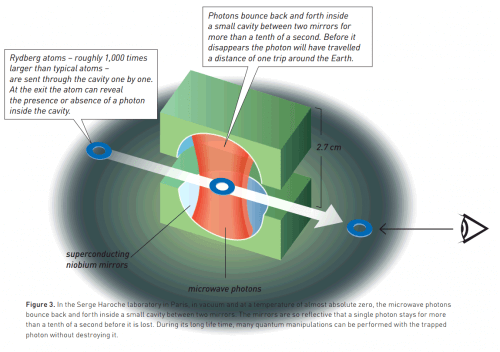
During this long lifetime many quantum experiments can be performed with the trapped photon. Herush prepared special atoms called "Rydberg atoms" whose purpose is to both control and measure the behavior of microwave photons in space. A Rydberg atom has a radius of 125 nanometers, which is a thousand times larger than the radius of ordinary atoms. These relatively "huge" atoms are flown at a controlled speed, one after the other, towards space, where their interaction with the trapped photon can be examined.
The Rydberg atoms go in and out of space while leaving the trapped photon there. However, the interaction between the photon and the atom causes a change in the instance (phase) of the quantum state of the atom: if we think of the quantum state of the atom as a wave, then its high and low points will be shifted to a certain extent. This deviation in the event can be measured when the atom exists in space, and by this it is possible to find out whether the photon is indeed in space or not. When there is no photon there, it is obvious that there will be no deviation. That is, with Hech's method, a photon can be measured without destroying it.
Using a similar method, Herush and his research group can count the photons inside space, just like a child counting his marbles. It sounds simple, but it requires extraordinary skill and skill since photons, unlike marbles, are destroyed immediately after they come into contact with the world around them. Based on his photon-counting method, Roche and his research colleagues developed methods for tracking the time evolution of an individual quantum state, step by step, in real time.
The paradoxes of quantum mechanics
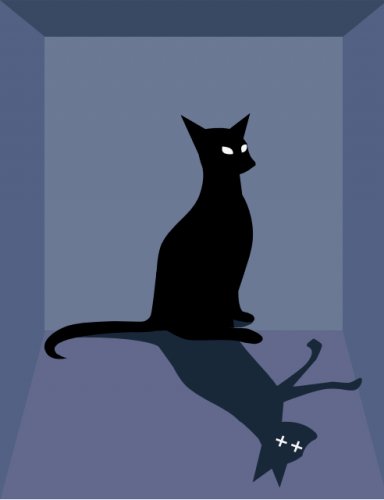
Quantum mechanics describes a microscopic world that is not visible to the ordinary eye, where events occur that contradict our expectations and experience from physical phenomena in the classical, macroscopic world. Physicists in the quantum world accept a certain level of uncertainty or randomness built into the systems of this world. One of the examples of opposite behavior than expected is the so-called "composition-states" where a quantum particle may simultaneously be in several different states. We don't normally think that a marble can be both "here" and "there" at the same time, but this is exactly the case if it were a quantum "marble". The composition of the states of the exile tells us what the exact probability of its being "here" or "there" would be, if we could measure it.
Why were we never aware of these surprising facts about our world? Why can't we observe the composition of states of a quantum sphere in our everyday life? The Austrian physicist, winner of the Nobel Prize (for physics in 1933) Erwin Schrödinger struggled hard with these questions. Like many other pioneers of quantum theory, he struggled to understand and interpret the implications of this world. In 1952 he wrote: "We never perform experiments with a single electron or atom or with a single small molecule. In highly planned experiments we sometimes believe that we are doing so; It always leads to ridiculous results..."
In order to describe the ridiculous results of the transition between the micro-world of quantum physics and the normal macro-world that we experience every day, Schrödinger devised a particularly clever experiment with a cat: Schrödinger's cat is in a box that is completely isolated from the outside world. In the box is also a bottle of deadly cyanide that is released after the decay of a certain radioactive atom, which is also in the box.
The radioactive decay is dictated by the laws of quantum physics, according to which the material is in states of decay where it has both had time to decay and has not yet decayed. Therefore, the cat is also supposed to be in a composition of states of being both alive and dead. Now, if we look inside the box, we risk killing the cat because the quantum combination of states is so sensitive to interactions with the outside world that any attempt to look at the cat will immediately result in the collapse of the dual state and we will receive only one of them - a live cat or a dead cat. In Schrödinger's eyes, this clever experiment leads to a ridiculous conclusion, and it is claimed that he later apologized for spreading confusion in the field of quantum physics.
The two 2012 Nobel laureates managed to map the cat's dual quantum state while exposed to the outside world. They devised creative experiments and managed to prove in great detail how the very act of measurement actually causes the collapse of the quantum state and the loss of the character of the composition of states. Instead of using Schrödinger's cat, Weinland and Roche trapped quantum particles and placed them in a composition of states similar to the cat's dual state. These quantum objects are not really macroscopic like the cat example, but they are still relatively large in terms of the quantum world.
Inside the space of the hemlock, photons are placed in states similar to the double state of the cat when their occurrences oppose each other at the same time, like a stopwatch where the needle moves both clockwise and counterclockwise at the same time. The photon field that exists in space was then examined by Atomi Rydberg. The result of this is another unstructured quantum phenomenon known as "quantum entanglement". This entanglement was also described by Schrödinger and it may occur between two or more quantum particles that are not in direct contact with each other, but can still "sense" and affect the properties of the other particle. The interweaving of the microwave field and the Rydberg atoms allow Herruch to map the properties of the double state within the space, following it step by step, atom by atom, as it moves from a state of quantum state composition to a well-defined state that we understand according to the laws of classical physics.
On the brink of a new computing revolution
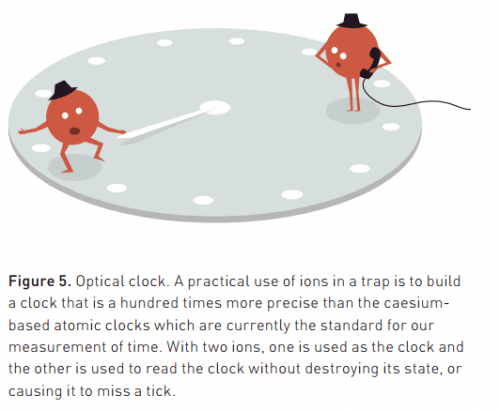
One possible application of the ion traps that many scientists dream of is a quantum computer. In the computers that we use today in our daily lives, the smallest unit of information is a bit (binary number, bit) which receives the value of one or zero. However, in a quantum computer, the basic unit of information - a qubit - can be one or zero at the same time. Two qubits can simultaneously have four different values - 00, 01, 10 and 11 - and each additional qubit doubles the number of possible states. For nqubits there are 2n possible states, and a quantum computer with only 300 qubits can contain 2300 values simultaneously, more than the number of all atoms in the universe.
Vinland's group was the first ever in the world to demonstrate two-qubit quantum action. Since control operations on a number of qubits have already been achieved, in principle there is no reason to believe that this would not be possible for such an operation on a larger number of qubits. However, in order to build a quantum computer of this kind, great practical challenges must be overcome. One challenge is to achieve two opposing requirements: it is necessary for the qubits to be properly isolated from their environment so that their quantum properties are not destroyed, and at the same time they must be able to communicate with the outside world in order to transmit the results of the calculations made with their help. It is possible that the first quantum computer will indeed be built in this century. If it does happen, it should change our lives in the same radical way that the classical illustration changed our lives in the last century.
New watches
Weinland and his research group also used trapped ions to build a clock that was a thousand times more accurate than today's sealed clocks that are our standard unit of time. World time, the hour, is kept by aligning all clocks relative to a single standard. Sealed clocks, cesium clocks, operate in the microwave range, while Vineland's ion clocks make use of visible light - hence their name: optical clocks. An optical clock can contain only one or two trapped ions. When two ions are used, one is used as a clock and the other is used to read the clock without destroying its state, or causing it to miss a second.
Thanks to such precise time measurements, it was possible to observe subtle and wonderful natural phenomena such as changes in the flow of time, or tiny changes in gravity, in the texture of space-time. According to Einstein's theory of relativity, time is affected by motion and gravity. The higher the speed and the stronger the movement, the slower the passage of time becomes. We may not be fully aware of these effects, but they have become a real part of our daily lives. When we navigate with a GPS navigator, we rely on time signals coming from satellites with clocks that move direction at a regular rate, since gravity is slightly weaker in the sky. With the help of an optical clock, it is possible to measure the differences in the passage of time when the speed of the clock changes by less than ten meters per second, or when gravity changes as a result of a difference in heights of only 30 cm.

5 תגובות
You can transfer information back in time with the help of the topic, change the state of a particle, and check statistically how it affected the past. And if you check several particles at the same time and in a circle, you can move back in time with knowledge. Thanks .
Amazing and fascinating. Write in a way that allows even non-professionals to understand and be impressed.
exciting